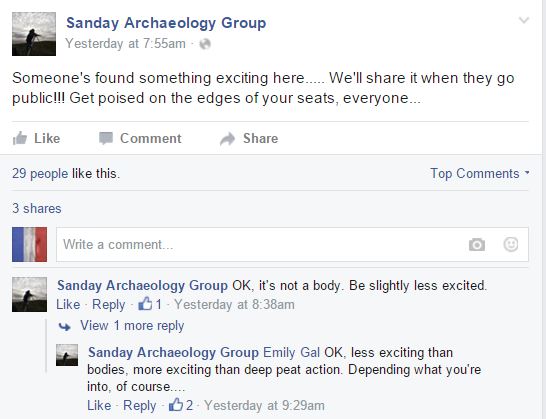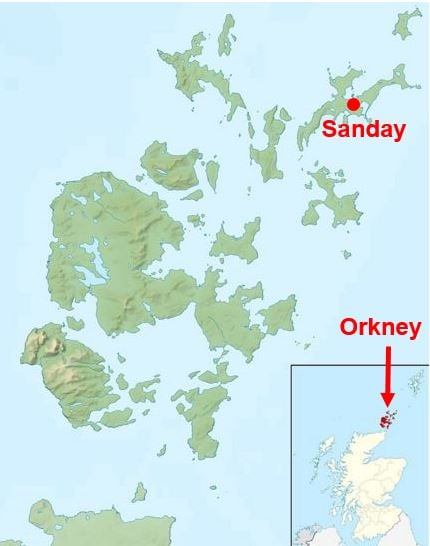A significant complex of Bronze Age buildings have been discovered at Tresness in Sanday, Orkney, an archipelago off the northeastern coast of Scotland. The researchers described their finds – which are probably over 4,000 years old – as one of the largest and most complex Bronze Age settlements in the Scottish Isles.
Such findings are often made when you least expect them, and that is exactly what occurred on Monday, 7th December at Tresness, Sanday, the scientists explained.
In very poor weather conditions, Professor Colin Richards, of the University of Manchester, Dr. Vicki Cummings, of the University of Central Lancaster, Christopher Lee and Professor Jane Downes, both from the University of the Highlands and Islands, were walking out to Tresness to examine an eroding stalled cairn (a mound of rough stones built as a memorial or landmark) on the point.
 Professor Jane Downes examining one of the Bronze Age house structures on the beach. (Image: https://archaeologyorkney)
Professor Jane Downes examining one of the Bronze Age house structures on the beach. (Image: https://archaeologyorkney)
Spread of stones turned out to be 14 prehistoric houses
At first, Mr. Lee saw what looked like the top of a large cairn of stones emerging through the sand. Then Dr. Cummings and Prof. Downes spotted a circular spread of stones lying close by in the intertidal zone on the western side of the ness.
Upon investigating the spread, a large number of stone bars, hammerstones, stone flaked knives, stone mattocks and ard-points became clearly visible on the surface.
As they examined more closely they saw sections of uprights and stone walls, which were clearly part of the structure of a house.
They soon saw another spread of stones lying a few metres away, which also belonged to another house structure covered with a mass of stone tools. As the amazed scientists walked on, they discovered several Bronze Age sites.
The fourteen houses are visible as differently-shaped arrangements of stones, stretching for more than one kilometer along the sand.
This extensive spread of Bronze Age houses appears to have been buried under the massive sand-dunes that characterise the approach to Tresness. Several of them appear to be in the process of eroding beneath the complex of dunes.
 It was not long before an excited Sanday Archaeology Group posted news of an amazing find on social media. (Image: facebook.com/sandayarchaeologygroup)
It was not long before an excited Sanday Archaeology Group posted news of an amazing find on social media. (Image: facebook.com/sandayarchaeologygroup)
Their discovery revealed that an entire Bronze Age landscape on Sanday was covered by sand dunes formed in the second millennium BC.
Team amazed by the scale of occupation
As the archaeologists proceeded along the ness, they were especially surprised by the density and scale of occupation.
Both the house structures are present and the working areas clearly visible. Prof. Downes, a Bronze Age specialist, was astonished by the vastness of the settlement areas.
Prof. Downes exclaimed:
“This must be one of the biggest complexes of Bronze Age settlement in the Scottish isles, rivalling the spreads of hut circles in other parts of mainland Scotland.”
We know very little about the Bronze Age in the Orkney Islands. In terms of settlement associated with agricultural practices, it is probably the least understood period of Orcadian history, the researchers explained.
 Sanday is in Orkney (Orkney Islands), a group of Islands off the northeast coast of Scotland. (Image: Wikipedia)
Sanday is in Orkney (Orkney Islands), a group of Islands off the northeast coast of Scotland. (Image: Wikipedia)
The enormous quantity of ard-points shows that arable agriculture dominated Orcadian lifestyles four thousand years ago.
Prof Downs noted that the finds confirm the strange practice of placing several ard-points and stone tools in houses after they were ‘decommissioned’.
Similar Bronze Age dwellings have been unearthed recently at the Links of Noltland, Westray. However, the vastness of the Sanday finds is unparalleled in Orkney, the archaeologists said.
Find will help better understand this period of Orcadian pre-history
An excited leader of the Sanday Archaeology Group, Cath Parker, said:
“This is incredibly exciting. The archaeological landscape concealed beneath Sanday’s shifting sands never ceases to amaze us. I’m sure the local community will relish the opportunity to be involved with any work which stems from this thrilling discovery.”
This latest discovery offers the chance to examine a dispersed Bronze Age settlement context in detail, which the scientists believe will shed new light on this rather obscure period of Orcadian pre-history.
Prof. Richards said:
“After a long history of excavating the large late Neolithic settlements or ‘villages’, most recently the Ness of Brodgar and Links of Noltland, we now possess a detailed understanding of Neolithic life in Orkney, but what happens in the following Bronze Age period is a bit of a mystery.”
This settlement complex is under considerable threat from coastal erosion, given its intertidal location. It is only a matter of time before everything erodes completely.

